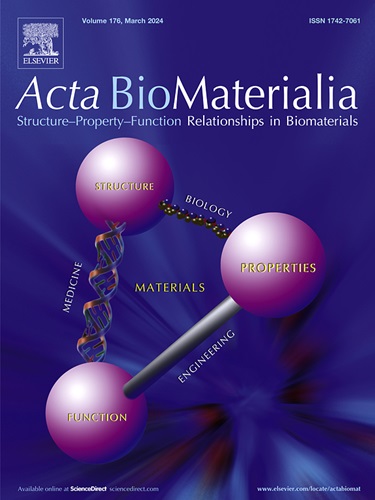Spontaneous bone regeneration achieved through one-step alignment of human mesenchymal stem cell-embedded collagen
IF 9.4
1区 医学
Q1 ENGINEERING, BIOMEDICAL
引用次数: 0
Abstract
Optimizing cell-matrix interactions for effective bone regeneration remains a significant hurdle in tissue engineering. This study presents a novel approach by developing a human mesenchymal stem cells (hMSCs)-embedded 3D aligned collagen for enhanced bone regeneration. A one-step mechanical strain was applied to a mixture of hMSCs and collagen, producing an hMSC-embedded, aligned 3D collagen hydrogel patch that mimics the natural bone matrix. Notably, the hMSCs embedded in the aligned collagen spontaneously differentiated into osteoblasts without external inducing reagents. Immunofluorescence analysis revealed that the BMP2-smad1/5 signaling pathway, critical for osteogenic differentiation, were activated by aligned collagen. In vivo experiments using a calvarial defect model confirmed that this approach effectively promotes new bone formation, starting centrally within the defect rather than from the edges adjacent to the existing bone. Our findings suggest that this simple method of pre-straining to create aligned 3D collagen embedded with hMSCs holds promise as a novel cell therapy platform for bone regeneration.
Statement of Significance
This study introduces a novel method for enhancing bone regeneration by developing a 3D aligned collagen patch embedded with hMSCs. A single mechanical strain applied to the hMSC-collagen mixture produces an aligned collagen matrix that mimics natural bone tissue. Remarkably, the hMSCs spontaneously differentiate into osteoblasts in the absence of exogenous inducing reagents triggered by activation of the bone morphogenetic protein signaling pathway. In vivo studies using a calvarial defect model confirm effective bone regeneration, initiating the new bone generation from the center of the defect. This approach offers a promising and simple cell therapy platform for bone repair, with broad implications for tissue engineering and regenerative medicine.

通过人间充质干细胞包埋的胶原蛋白一步排列实现自发骨再生。
优化细胞-基质相互作用以实现有效的骨再生仍然是组织工程中的一个重大障碍。本研究提出了一种新的方法,通过开发一种嵌入hmsc的3D排列胶原蛋白来增强骨再生。将一步机械应变作用于hmsc和胶原蛋白的混合物,产生一个嵌入hmsc的、排列的3D胶原蛋白水凝胶贴片,模仿天然骨基质。值得注意的是,嵌入排列的胶原中的hMSCs在没有外部诱导试剂的情况下自发分化为成骨细胞。免疫荧光分析显示,排列的胶原蛋白激活了成骨分化的关键信号通路BMP2-smad1/5。使用颅骨缺损模型的体内实验证实,这种方法有效地促进了新骨的形成,从缺损的中心开始,而不是从邻近现有骨的边缘开始。我们的研究结果表明,这种简单的预拉伸方法可以产生嵌入hMSCs的排列3D胶原蛋白,有望成为一种新的骨再生细胞治疗平台。意义声明:本研究介绍了一种通过开发嵌入人间充质干细胞(hMSCs)的3D排列胶原贴片来增强骨再生的新方法。对hmsc -胶原蛋白混合物施加单一的机械应变,产生一种排列整齐的胶原蛋白基质,模仿天然骨组织。值得注意的是,在没有外源诱导试剂的情况下,通过激活骨形态发生蛋白信号通路,hMSCs可以自发地分化成成骨细胞。使用颅骨缺损模型的体内研究证实了有效的骨再生,从缺损中心开始新骨生成。这种方法为骨修复提供了一种有前途的简单的细胞治疗平台,在组织工程和再生医学方面具有广泛的意义。
本文章由计算机程序翻译,如有差异,请以英文原文为准。
求助全文
约1分钟内获得全文
求助全文
来源期刊

Acta Biomaterialia
工程技术-材料科学:生物材料
CiteScore
16.80
自引率
3.10%
发文量
776
审稿时长
30 days
期刊介绍:
Acta Biomaterialia is a monthly peer-reviewed scientific journal published by Elsevier. The journal was established in January 2005. The editor-in-chief is W.R. Wagner (University of Pittsburgh). The journal covers research in biomaterials science, including the interrelationship of biomaterial structure and function from macroscale to nanoscale. Topical coverage includes biomedical and biocompatible materials.
 求助内容:
求助内容: 应助结果提醒方式:
应助结果提醒方式:


